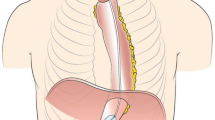Abstract
Background
The usual treatment of pyloroduodenal peptic stenosis has been mainly surgical, through pyloroplasty or gastric resection, with or without vagotomy. Since the first description of treatment for this peptic complication by endoscopic balloon dilation perfomed by Benjamin in 1982 [2], this procedure has become a therapeutic option in association with the medical treatment of peptic disease. The aim of this study is to evaluate the results involving clinical, endoscopic, and gastric emptying scintigraphy parameters.
Methods
Between August 1998 and February 2000, 20 patients with pyloroduodenal stenosis refractory to conservative treatment were treated at the Gastrointestinal Endoscopy Unit of the University of São Paulo Medical School. All patients who presented clinical manifestations of pyloroduodenal stenosis underwent upper gastrointestinal endoscopy to confirm peptic stenosis. Biopsy of the narrowing for the confirmation of a benign disease and gastric biopsy for Helicobacter pylori detection were performed. The treatment consisted of dilation of the stenosis with type TTS (Through The Scope) hydrostatic balloon under endoscopic control, treatment of Helicobacter pylori infection, and gastric acid suppression with oral administration of proton pump inhibitor. All patients, except one who was excluded from this study, were submitted to a clinical endoscopic assessment and gastric emptying evaluation by ingestion of 99mTc before and after the treatment. Endoscopic evaluation considered the diameter of the stenotic area before and after treatment. A scintigraphic study compared the time of gastric emptying before and after balloon dilation.
Results
Nineteen patients completed treatment by hydrostatic balloon dilation. Clinical symptoms such as bloating (p < 0.0001), epigastric pain (p = 0.0159), gastric stasis (p < 0.0001), and weight gain (p = 0.036) showed significant improvement. The diameter of the stenotic area increased significantly (p < 0.01) after the dilation treatment as well as a better gastric emptying of 99mTc (p < 0.0001).
Conclusion
The dilation of the peptic pyloroduodenal stenosis using a hydrostatic balloon is a safe and effective procedure. The evaluation with gastric scintigraphy by ingestion of 99mTc is an effective method of assessment for the improvement of gastric function, because its results corresponded to the clinical improvement after endoscopic treatment.




Similar content being viewed by others
References
Awan A, Johnston ED, Jamal MM, et al. (1998) Gastric outlet obstruction with benign endoscopic biopsy should be further explored for malignancy. Gastrointest Endosc 48(5): 497–500
Benjamin SB, Glass RL, Cattau EL, Miller WB, et al. (1984) Preliminary experience with balloon dilation of pylorus. Gastrointest Endosc 30: 93
Benjamin SB, Cattau EL, Glass RL, et al. (1982) Balloon dilation of the pylorus: therapy for gastric outlet obstruction. Gastrointest Endosc 28: 243–244
Bockus (1985) Gastroenterology, vol 2, 4th ed, pp 1155–1183
Craig PI, Gileespie PE, et al. (1988) Through the endoscope balloon dilation of benign gastic outlet obstrution. Br Med J 197: 396
Di Sario JA, Fennerty MB, Tietze CC, Hutson WR, Burt RW, et al. (1994) Endoscopic balloon dilation for gastric ulcer outlet obstruction. Am J Gastroenterol 89(6): 868–871
Engler-Pinto P Jr, Gama-Rodrigues J, Lopasso FP, et al. (1996) Site of pepitc ulcer. Comparison of hydrocholoric acid output, pepsinogen and gastrin serum levels. Hepatogastroenterology 43: 1671–1677
Engler-Pinto P Jr, Meneguetti C, Lopasso FP, et al. (1995) Identification of heterogenous motility patterns of the stomach in duodenal ulcer disease. Rev Hosp Clin Fac Med Sao Paulo 50: 267–271
Graham DY, Schwartz JT, Smith JL, et al. (1987) Evaluation of effectiveness of through-the-scope as dilators of benign and malignant gastrointestinal strictures. Gastrointest Endosc 33: 432
Grundy A, Belli A, et al. (1988) Balloon dilation of upper gastrointestinal tract strictures. Clin Radiol 39: 229–235
Hewitt PM, Krieg JEJ, Funnel EIC, et al. (1999) Endoscopic balloon dilation of peptic pyloro-duodenal strictures. J Clin Gastroenterol 28: 33–35
Högström HL, Haglund UA, et al. (1984) Technique for endoscopic balloon dilation of pyloric stenoses. Endoscopy 17: 224
Judd DR, Simmnos RD, Kelley W, Newton WT, et al. (1970) Gastric outlet obstruction due to peptic ulcer. Arch Surg 100(1): 90–93
Kerrigan DD, Read NW, Houghton LA, et al. (1991) Disturbed gastroduodenal motility in patients with active and healed duodenal ulceration. Gastroenterology 100: 892–909
Kozarek RA, et al. (1986) Hydrostatic balloon dilation of gastrointestinal stenoses: a national survey. Gastrointest Endosc 32: 15
Lau JYW, Chung SCS, Sung JJY, et al. (1996) Through-the-scope balloon dilation for pyloric stenosis: long term results. Gastrointest Endosc 43(2): 98–101
Lindor KD, Ott BJ, Houghes RW, et al. (1985) Balloon dilation of upper digestive tract. Gastroenterology 89: 545–548
McLean GK, Cooper GS, Hartz WM, et al. (1987) Radiologically guided balloon dilation of gastrointestinal strictures. Part I. Technique and factors influencing procedural success. Radiology 165: 35–40
McLean GK, Cooper GS, Hartz WM, et al. (1987) Radiologically guided balloon dilation of gastrointestinal strictures. Part II. Results of long-term follow-up. Radiology 165: 41–43
Schmüdderch W, Harloff M, Riemann, JF et al. (1989) Through-the-scope balloon dilation of benign pyloric stenoses. Endoscopy 21: 7–10
Author information
Authors and Affiliations
Corresponding author
Rights and permissions
About this article
Cite this article
Artifon, E.L.A., Sakai, P., Hondo, F.Y. et al. An evaluation of gastric scintigraphy pre- and postpyloroduodenal peptic stenosis dilation. Surg Endosc 20, 243–248 (2006). https://doi.org/10.1007/s00464-005-0129-2
Received:
Accepted:
Published:
Issue Date:
DOI: https://doi.org/10.1007/s00464-005-0129-2




